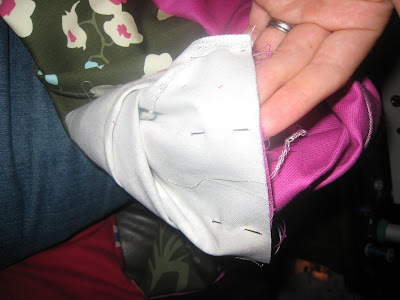
Which works fine for most sleeves. But over the summer when I was making a bunch of hoodies, I literally stared at my sleeve edges as a full time job because I couldn't figure how to get the ribbing in there. I tried a million different ways, but one night I had a light bulb moment after hand stitching them in and then pulling them through various openings and it's not that hard. Honest. You have to trust me, it probably won't make sense until you do it.
- After you have attached your two sides together, turn your garment right side out through the hole you have left open. This might be at the hem or the side seam of you lining, depending on which pattern / tutorial your following.
- When your garment is right sides out, pull both your shell and lining sleeves on one side through your open hole. You will be seeing the wrong sides of the sleeves.
I find it easier to pull them all the way out to the armpit seam, so you can make sure than neither has been twisted around. There is nothing more frustrating than sewing the sleeves together and then finding that one has been twisted, including local government red tape and international call centres.
- Fold each edge of your sleeve down approximately an inch. At the side seams of both your sleeves, pinch together the bits you've folded.

- While still pinching together, unfold one sleeve onto the top of the other sleeve. The raw edges of both sleeves will match up.
- Pin both layers together around the whole sleeve edge. This is how it will look before stitching, with both sleeves separate but aligned and pinned at the raw edge.
- Carefully stitch around the sleeve edge.
This is tricky because you will have to constantly move extra fabric out of the way and the sleeves will do a full revolution twist by the time you finish. This would be a good time to pour yourself a stiff drink.
- Examine both sides to make sure nothing extra has been caught. It will look like this:
- Push them back into the hole and then pull out through the right side of the jacket through the armhole:
- Pat yourself on the back for your lovely neat edges:







Thanks for sharing the tip with us :)
ReplyDeleteSeriously, I mean it, I have been waiting to find out how you do this...not to be silly and over dramatic but.wow. my mind is blown...makes perfect sense yet I would never have been able to figure it out..Thank you!!! made my day :)
ReplyDeleteThis is precisely why I only make things with straight lines ...
ReplyDeleteBunting - straight lines
Pe Bags - straight lines
Cushions - straight lines
Doorstops - straight lines
(Get the idea?)
You're such a sewing genius
xx
you life saver!!! now i just need to figure out how to do the rest of the hoodie and do my 1st ever ZIP!! argh!
ReplyDeletewish me luck! xx
Thank you for posting this! It's exactly what I need.... and it makes so much easy sense once you get your mind wrapped around the spatial geometry of it. I would never have thought of it on my own. Thank goodness for crafters who give out their knowledge for free!
ReplyDelete*love*
ReplyDeleteThank you! I've been working on this for 5 effing days! You rock! (and you're right. it does make sense once you're doing it.)